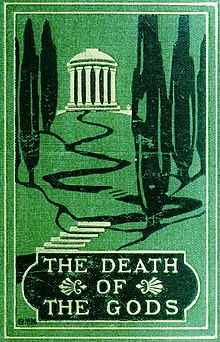|
The Death of the Gods
The Death of the Gods. Julian the Apostate (Russian: Смерть богов. Юлиан Отступник, romanized: Smert bogov. Yulian-Otstupnik) is a novel by Dmitry Merezhkovsky, first published (under the title The Outcast, Russian: Отверженный, romanized: Otverzhenny) in 1895 by Severny Vestnik. Exploring the theme of the 'two truths', those of Christianity and the Paganism, and developing Merezhkovsky's own religious theory of the Third Testament, it became the first in "The Christ and Antichrist" trilogy. The novel made Merezhkovsky a well-known author both in Russia and Western Europe although the initial response to it at home was lukewarm.[1][2] BackgroundMerezhkovsky started working upon the novel in the summer of 1890. The process was boosted by the Merezhkovskys' 1892 journey abroad, during which the couple visited Greece and Turkey. Merezhkovsky’s first impressions of Greece were not favourable but everything changed as he found himself facing the sacred hill of Acropolis.
Upon the return, the couple found themselves in serious financial difficulties. "We literally have nothing to eat and we've pawned our wedding rings," Zinaida Gippius complained in one of her 1894 letters. Dogged by poverty, Merezhkovsky still managed to finish the novel.[2] History The Death of the Gods (according to critic Dina Magomedova) was "the first in a long series of Merezhkovsky's books rejected, violated by censors or confiscated by the police." As the novel was finished, none of the Russian magazines wanted to have anything to do with it, according to Gippius. In 1895 Severny Vestnik published it, but not in its original form and under another title, editor Akim Volynsky having subjected the text to severe editing.[5] The one person who took Merezhkovsky's novel seriously, was the Russian Literary Fund chairman Pyotr Veinberg. He started to invite the young author (now labeled "a decadent" by the press) to his prestigious literary parties and this got things going. "One really should understand the atmosphere of the times to see how cheeky a venture this was. Merging the young writers with the old, Veinberg was making the public more and more tolerant to radical newcomers," Zinaida Gippius later remembered. Veinberg was the first of the old school of the Russian men of literature who fully supported the novel. He organized the public reading of it in his own house and thus helped it gain more support.[3] The novel enjoyed mass popularity and provoked heated debate. Even most ardent detractors (who were denouncing the young author as "a Nietzschean") had to acknowledge the merits of what turned out to be the first Symbolist novel in Russia: the profound knowledge of history and fine, subtle language. This, according to biographer Yuri Zobnin, distinguished it from other Russian historical novels, set in the tradition started by Nikolay Danilevsky.[5] The conceptThe novel tells the story of Roman Emperor Julian who during his reign (361–363) was trying to restore the cult of Olympian gods in Rome, resisting the upcoming Christianity. Christianity "in its highest manifestations is presented in the novel as a cult of an absolute virtue, unattainable on Earth which is in denial of all things Earthly," according to scholar Z.G.Mints. Ascetic to the point of being inhuman, early Christians reject reality as such. As the mother of a Christian youth Juventine curses "those servants of the Crucified" who "tear children off their mothers," hate life itself and destroy "things that are great and saintly," the elder Didim replies: a worthy follower of Christ is to learn to "hate their mother and father, wife, children, brothers and sisters, and their very own life too."[3] The author (who sees Christ as "life's sworn enemy") sympathizes with his doomed hero. The advent of Christianity in the novel is presented as "the victory for evil and blind mob," who treat "Julian as not just an Apostate, but Antichrist," according to modern critic and biographer Oleg Mikhaylov. Biographers saw Julian's spiritual quest as something parallel to the ideas Merezhkovsky started to develop in the 1880s–1890s. The Emperor in the novel, acknowledging the "beautiful loftiness of Christian sermon," refuses to accept it, seeing it as a denial of the human sensuality and humanity as such.[2] One of the novel's main ideas is that man's suffering stems from the conflict between the spirit and the flesh. The author conceded later that his initial philosophical approach was too straightforward and explained the way it changed:
Nevertheless, as later critics noted, every single one of Merezhkovsky's protagonists starting with Leonardo da Vinci, Peter the Great, Alexander I, were "spiritual twins" of Julian, seeking the harmonious unity of spirit and flesh here on Earth.[2] Of the novels's Nietzschean tendencies, philosopher Ivan Ilyin later wrote:
References
External links
|
||||||||||||||||
